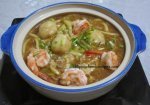Cooking Rice, the Filipino Way
Cooking rice used to be a struggle.
In the Philippines, I believe that learning to cook rice is one of the very first things a mother teaches her daughter in the kitchen. My mom used to tell me that grandma would quip to her and her 6 sisters : “your husbands will return you back to me if you can’t cook rice…”
That’s because we, Filipinos have different preferences when it comes to rice. Some like it loose and fluffy (buhaghag), others like it gooey and very sticky(malata) , and still a lot others like it in between.
Back in the Philippines, we used to cook white rice only through this : in a pot with simmering water on a stove top. Some call it the absorption method. (See below for the detailed procedure.)
Nowadays, however, cooking rice is as easy as boiling water…thanks to the Electric Rice Cooker!
And did you know that you can now cook rice in the microwave, too?

This is the Microwave Rice Cooker. It is very handy to bring anywhere and ready to go inside the refrigerator if you need to set aside leftovers.
Most Filipino households now own a rice cooker, it’s actually more of a necessity, just like the frying pan or the water kettle.
But, even today, the challenge is still : how much water to use?
For a Jasmine or Milagrosa rice :
- I use a 1:1 ratio for the Electric Rice Cooker. One cup of water for every cup of rice grain. For a more sticky consistency, add up to 1/2 cup to 1 cup water.
- Growing up in the Philippines, I was taught of this very interesting way of measuring the water volume.

While the tip of the middle finger is touching the rice, the water should reach up to the second line or phalanx, as shown.
I still use this particular method for the traditional Absorption cooking or when I'm using the Microwave Rice Cooker.
Very strange, I know, but quite effective in my experience.
ABSORPTION METHOD OF COOKING RICE
1 Wash the rice thoroughly. Check for small pebbles or rice husks.
2 Wash a second time(and a third) if you want to wash off some of the starches to make it a little less sticky and fluffy when cooked.
3 Put a pinch of salt (optional).
4 Measure the water. You could use a 1:1 1/2 or 1:2 rice to water ratio or use the finger-measure method explained above.
5 Bring the water to a boil, then turn the heat down to simmer for 20 minutes or until the rice has fully absorbed the water.
6 Let it stand for a few minutes so the top surface is not too wet. Fluff while still hot.
BENG'S TIPS
- Fluffing the rice with a fork while it is still hot will make it less sticky and scooping will be much easier.
- Back home in the Philippines, we used to wash rice 2-3 times to remove the impurities like small pebbles, dirt and rice husks. With the rice here in the US, however, that is not necessary. One washing is enough since you will hardly find any dirt or husks. Besides, too many washings may remove some of the nutrients of the rice.
- My father used to instuct us to salt the sinaing (rice) otherwise the taste is very bland, but I never got into that habit. Now, almost all cookbooks on rice will tell you to salt the rice before cooking it - but it's all really up to you.
Return to Filipino Cooking How To's
Return to Home Page
Return to Cooking Rice Top page


